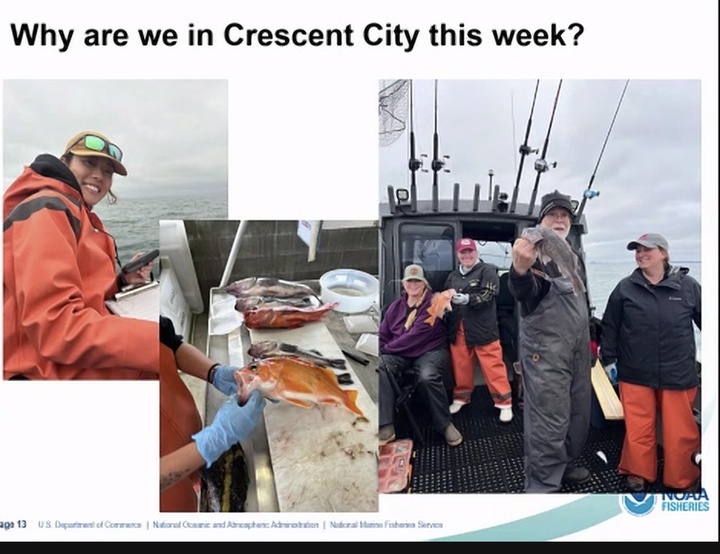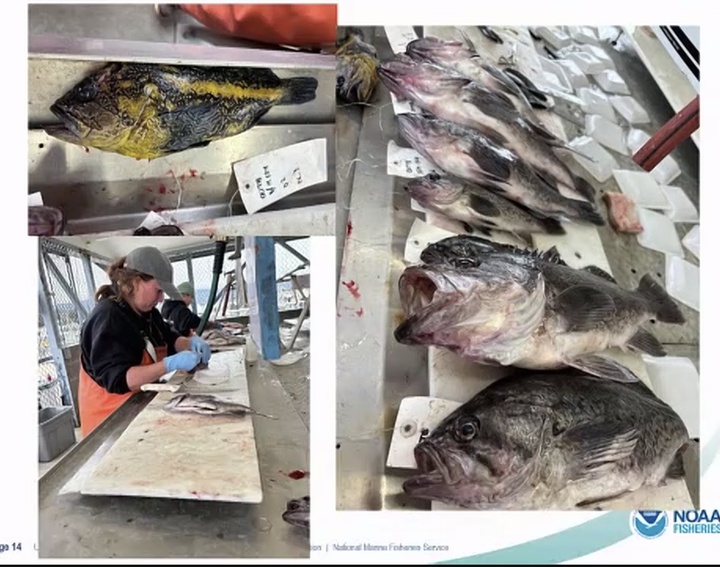Jessica Cejnar Andrews / Thursday, March 21, 2024 @ 4:59 p.m. / Ocean
NOAA Scientists Collect Groundfish Data From Del Norte; Fishing Group Reps Urge Anglers To Avoid Keeping 'Colored' Rockfish

Jessica Choi, Melissa Monk and other NOAA scientists joined local fishing guide Steve Huber to collect data on nearshore rockfish. | Screenshot
Previously:
• Del Norte Fishermen Are Pissed About Nearshore Groundfish Fishery Closure
###
Though they’ll be able to go fishing starting April 1, Steve Huber urged local anglers to keep their catch of copper, vermilion, China and other “colored rockfish” to a minimum.
It would benefit the stock in the long run to release those fish with a descending device, the owner of Crescent City Fishing Charters told the Wild Rivers Outpost on Thursday. Fishermen should go after black and blue rockfish instead. Quillback — the species behind last year’s emergency closure — are verboten.
“We’re hoping that everybody jumps on board and makes this a no-colored season this year,” Huber said Wednesday at a special meeting of Del Norte County’s Natural Resources and Environmental Coordination Technical Advisory Committee. “Every colored fish that comes in this season is going to have an effect for a long time for us in the next couple of seasons that come in. If we take a bunch of those fish, even though we’re allowed to take them, it’s going to have an effect what we have for fishing the following year.”
Colored rockfish include the copper rockfish, with its dark brown to orange-red body; the China rockfish, with its yellow band on its lateral line; and the red vermillion rockfish, according to Huber. He said he also considers quillback rockfish colored rockfish.
On March 10, in addition to greenlighting a 2024 nearshore groundfish season, the Pacific Fishery Management Council set a 2-fish bag limit for the vermillion rockfish and a one-fish bag limit for copper rockfish.
For the past seven months, Huber has spoken on behalf of the Crescent City Fishing Group and the Humboldt Area Saltwater Anglers group before the Pacific Fishery Management Council.

The fish on the top left is a China rockfish. NOAA scientists process other rockfish caught over the last two days near Crescent City. | Screenshot
The PFMC manages fisheries in federal waters along the West Coast. Idaho is also represented since the Council makes regulations concerning salmon.
Joining local elected officials, including Del Norte County supervisors Chris Howard and Joey Borges and Crescent City Mayor Blake Inscore at the Council’s most recent meeting in Fresno, Huber has argued for the need for better data regarding the status of the quillback rockfish.
In 2021, the National Marine Fisheries Service stated quillback rockfish in California were overfished. However, in June 2023 the PFMC approved a groundfish fisheries management plan that recommended establishing three separate quillback stocks for Washington, Oregon and California.
On Wednesday, Huber introduced the local fishing community to Melissa Monk, a research mathematical statistician stationed at the National Marine Fisheries Service’s Southwest Fisheries Science Center. Monk and her colleagues Jessica Choi, Rachel Brooks, Eric Johnston and Nancy Leonard spent two days with Huber conducting hook & line surveys in Del Norte waters.
“We hooked a lot of fish in the last two days and they measured them, got information from them and we descended every single fish we didn’t need for them to take,” he said. “I think we had one floater today and he slipped off the descending device, but the rest of those fish went down.”
A descending device will be mandatory for California anglers, Huber said. This will keep the mortality rate low, especially in 20 fathoms.
According to Monk, collecting the data for the PFMC to conduct a stock assessment is a two year process. In June, the Council will decide which species scientists will assess during the 2025 stock assessment cycle.
Scientists will gather data between June 2024 and April 2025. An independent review panel will analyze that data in summer 2025 and the PFMC will adopt the new assessments in September. Those stock assessments will be used to develop regulations for 2027 and 2028.
Out of more than 90 species of rockfish on the West Coast, Monk and her colleagues develop assessments for 64 species. This includes the copper rockfish which grows differently depending their sex and if they’re north or south of Point Conception in California.
Scientists with the PFMC’s northwest and southwest fisheries science centers work with commercial fleets, anglers with their own boats and charter captains who provide fishing experiences for paying passengers. A stock assessment is considered outdated at 10 years old, Monk said.
“What we’re trying to do is collect… all that growth information,” she said. “There is no other way [to do that] currently except to sacrifice the fish. What we do is take their otoliths, their ear bone.”
A rockfish’s sagittal otolith has rings like a tree and scientists can use them to gauge their age, Monk said. The Southwest Fishery Science Center has otoliths from the commercial groundfish fishery going back to the 1960s. She said they also work with the California Department of Fish and Wildlife to collect otoliths from the recreational fishery.
Southwest Fisheries Science Center also collects data through the California Collaborative Fisheries Research Program, which incorporates scientists from 16 coastal universities in the state along with recreational and commercial fishermen. It also allows NMFS scientists to gather data from the various marine protected areas between Southern California and Cape Mendocino.
According to Monk, one reason she and her colleagues are in Crescent City this week is to sample spawning rockfish. She and her colleagues were targeting quillback rockfish and caught two.
Monk said she hopes to return to sample for quillbacks before they’re done spawning. She also hopes to take samples in Eureka, Fort Bragg and the Farallon Islands to get a latitudinal range.
Monk said she and her colleagues were also able to sample spawning China rockfish along with canaries, coppers and vermilions.
“Every time we stopped, we put lines in the water, the data taker took information on the latitude and longitude, the depth, how many species were caught, the length of that species and whether it was male or female,” she said. “We got back to the fish cleaning station. We always process these fish and when I say process, what I mean is we pulled their otoliths out, then put them in envelopes. We weighed their livers, that tells us something about their body condition like how well they’re feeding. And then if they had eggs, we took samples of the eggs.”
According to Monk, she and her colleagues began collecting data through the Collaborative Fisheries Research Program about two summers ago. She said at least three years of data is needed to conduct updated stock assessments.
During the meeting, Kenyon Hensel, who has fished in Crescent City for 45 years and spent about 20 years working on the PFMC’s Groundfish Advisory Panel, said for 30 years anglers couldn’t go after “shelf species” in the rockfish conservation areas, which are depth-based areas closed to fishing.
“All of those fish have had 30 years of rebuilding and in my opinion we cannot have an overfished species anywhere from the shelf out to the slope, which is 150 fathoms or so,” Hensel said. “The fact that you’re having so much trouble with assessments is because you haven’t been able to integrate closed areas into stock assessments to show their effect.”
Hensel said the PFMC scientists should stop conducting stock assessments until the impacts a closure on a specific species can be determined.
Monk told Hensel that the PFMC has been discussing the benefits of a workshop focusing on areas that are closed to fishing.
In response to Hensel’s comment, Huber said the Groundfish Advisory Panel had to come up with the best scenario based on the data they had in front of them.
Earlier this month, the PFMC approved a recreational season north of the Monterey Bay Area shoreward of 50 fathoms, or 300 feet, during the month of April. From May through September, anglers will be able to fish shoreward of 20 fathoms, or 120 feet. During October, recreational fishermen will be able to return to fishing shoreward of 50 fathoms. That boundary shrinks again to shoreward of 20 fathoms in November and returns to shoreward of 50 fathoms in December.
Huber pointed out by fishing shoreward of 20 fathoms in November, recreational fishermen can also go after Dungeness crab.
Huber and fellow Crescent City Fishing Group member Andrea Spahn reminded anglers that descending devices are mandatory.
Spahn also urged local fishermen to help educate visitors. She noted that the Crescent City Harbor District already allowed the Crescent City Fishing Group to post reminding them that keeping quillback rockfish is illegal and urging them not to keep chinas, coppers, canaries and vermilions “because they are being looked at.”
“When you’re there loading your boat or unloading your boat, if you notice somebody new, try to nicely educate them,” she said. “You know, [say], ‘Please don’t keep these fish. We’re trying to keep our fishery open.’ We’re going to have waypoint literature down there and anything that we can get available to try and educate these people.”
CLICK TO MANAGE